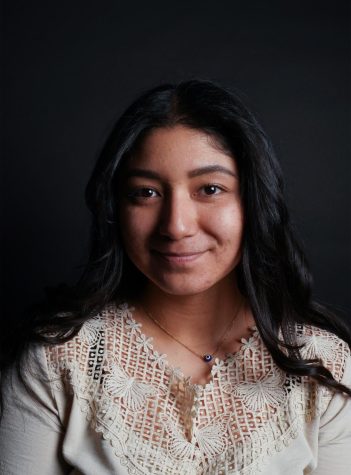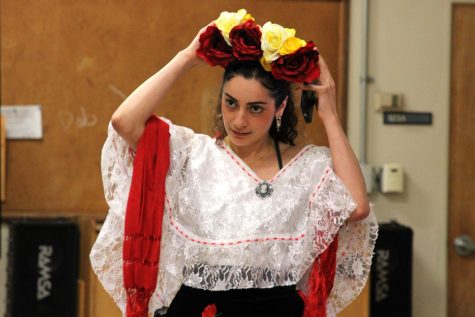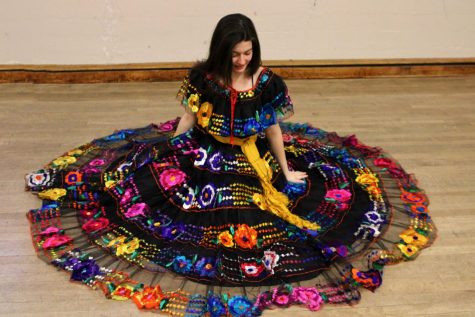



Ballet Folklórico class brings SF State students together for dances and history, reconnecting them to their roots.
Mar 11, 2023
Made in Mexico, the black shoes on each dancer’s feet synchronize to the music of different regions of the country. The taps of the shoes as they move to beats five, six, seven, eight connect each dancer to the essence of Latin America.
Debra Chantal Avelar-Castaneda, a first-generation Mexican American student at SF State, bought many pairs of folkloric shoes during her trip to Mexico before the semester started. The shoes are for her experimental college Ballet Folklórico Mexicano class, the first folklórico class offered at SF State.

“I made a goal to get shoes for anyone that wanted them,” Castaneda said. “I sent out an email to everyone who previously signed up for my class asking who wanted shoes, and if they weren’t able to afford them I’d try my best to just get it for them. I wanted everyone to feel included.”
Castaneda received monetary support from her mother for shoes, who reassured her the experience of teaching and sharing Mexican culture was more valuable than the money spent.
“My goal was to spread my culture through something I love,” Castaneda said. “It’s so interesting to me to see all these ethnic study classes and every time I come out learning more about my culture. And I know I have information about our culture that I could share or teach through dancing. It gave me a chance to put in my little grain of rice.”
This is Castaneda’s first time teaching a university course for EXCO focusing on basic folklórico steps, techniques and history, but this isn’t her first time teaching.
“I have been teaching folklórico since I was in elementary school. My teachers would ask me to show my peers a couple of moves for the showcases that we would do,” Castaneda said. “I decided to do a folklórico course because I feel like there are not enough options within the dance department for students to take. They are super limited. I believe this semester, we only have ballet and modern.”
Castaneda has been dancing folklórico for 14 years. The class will only be available this semester since Castaneda graduates this spring as a Dance major.
“What I do in my class is teach a little bit about a specific region in Mexico and to learn the steps, so I can then give them a bit of historical background before they start dancing to the music,” Castaneda said. “I feel like that helps you in the mindset you need for that specific dance. For example, there are regions in Mexico that are a little bit softer and the steps are either faster or slower and you hold your skirt a certain way because it symbolizes different meanings depending on the region.”
The class currently consists of seven students but the class is open to those who aren’t enrolled, allowing them to pop in whenever.
“I only do it on Thursdays because there’s a limit on time,” Castaneda said. “When it comes to teaching experimental college I believe an hour and 40 minutes that you’re allowed per week. So I’m only holding it on Thursdays from 4 p.m. to 5:45 p.m. I’ve had a good amount of Latino students but we also have a couple of Asian students and an exchange student from Turkey. It’s pretty cool to see other people from different cultures wanting to learn.”
Alara Tugcu, an exchange student from Turkey, joined folklórico out of enjoyment to learn more about new cultures.
“It’s beautiful, it really widens your horizon,” Tugcu said. “You want to learn every detail. It makes me want to learn about more cultures really. I don’t want to stop here. I want to learn everything about it.”

Tugcu found that the class’s format helped her feel less out of place learning something outside of her own culture.
“Debra doesn’t only teach the dance steps but the background and history, and then we learn the steps, so I feel like it’s easy to feel a better connection with the dance even though it’s not my own culture,” Tugcu said. “Those shoes that we use are shoes that I have never worn before, so they really hurt my feet and work my muscles a lot. After the first day of class when I first used the shoes, I was so sore but Debra said my body will get used to it.”
Tugcu is still adjusting to the shoes and outfits as her interest in folklórico continues to grow. Not only has the class introduced a new culture to some, but it has also reconnected others to their origins.
Daniella Shofani, a fifth-year student majoring in Dance, decided to join folklórico to connect to her Mexican side.
“I am half Palestinian and half Mexican,” Shofani said. “Taking this class means connecting with an aspect of my Mexican identity. I feel like I have to balance it out with something as simple as listening to Mexican music. When I feel like I’m a bit distant from one I’ll connect to it with music.”
Growing up, Shofani was more immersed in her father’s Palestinian culture, so she felt like it was the more dominant culture in her life. Being part of the Ballet Folklórico class has allowed her to build that connection to her other half.
“Debra taught me to be more proud, not that I was never proud of my identity but to connect more with it as it is still a part of who I am,” Shofani said. “She helps me have those conversations that help us think and critically analyze Mexican culture.”
Bryan Aguilar, a business major with a concentration in finance, was looking for a class to fulfill the graduation unit requirements in the fall and stumbled across the Ballet Folklórico class. Serendipitously, it also helped him connect to his Mexican roots.
“I was talking to my academic advisor and figured out that I was going to finish my required classes with one unit left,” Aguilar said. “So I looked into what one-unit courses there were and found folklórico. I am Mexican and I thought that learning about folklórico would make me closer to my heritage.”
Aguilar is the only male enrolled in the Ballet Folklórico class.
“It does feel a little weird just because it’s a more female-led dance and they take all the attention with the beautiful dresses but it still feels nice learning about it,” Aguilar said. “It was nerve-racking the first week but as soon as I got to know them I felt comfortable.”
This is Aguilar’s first time taking a dancing class.
“When I signed up for the class, I was excited to tell my parents because this is an ethnic class that they wouldn’t expect in an American college,” Aguilar said. “My parents are very connected to their roots and you know, I am too, but not to the same extent. So when I told them I was doing this, they were pretty excited. It was a moment of happiness that I was going to learn something about my own roots and automatically connect me deeper.”
Aguilar noticed a pattern during his search for a class to fulfill the single-unit requirement.
“When I was looking for one-unit courses, it was more of the ethnic stuff,” Aguilar said. “One of the girls was sharing that it almost seems like all the ethnic classes are least important. They are one unit,” Aguilar said. “I did take this class because I needed the one unit but if this class was a bigger deal it would be a full-time course. I feel like they don’t get the respect they deserve.”
During a class, Shofani said that cultural dancing seems like it is considered second best since it isn’t pushed as much, which gave Castaneda another reason to create the class. Not only do her students feel a sense of connection to their roots but so does she.
“Being here in the United States and not being able to go back home to Mexico because of my parents, it made me feel like I have a place where I can fit in and be part of my culture without feeling like I’m half here, half there,” Castaneda said. “ I feel like that dance just does that for you. It just brings people together.”

